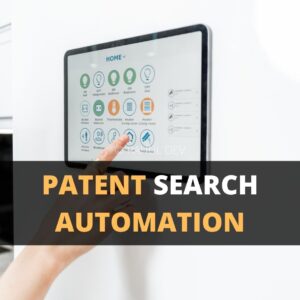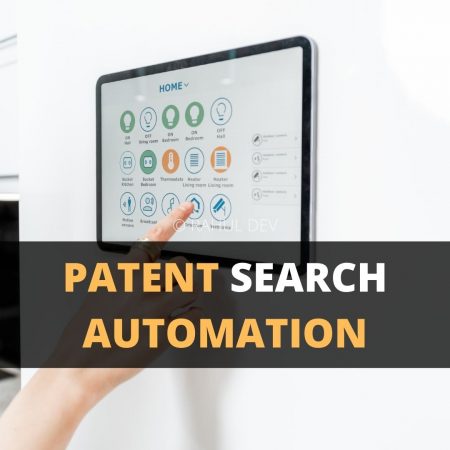Patent Search Automation
Explore the Process to Automate Patent Search Process

Understand Practical Aspects
Understand how to use AI for patent searches

Explore the Process to Automate Patent Search Process

Understand how to use AI for patent searches

Protect your innovations across multiple countries and create strong patent portfolio to boost business valuation
Local and global brand protection through international trademark registrations
Extensive research and business writing for technical whitepapers and B2B content products
This guide covers role of AI and Machine Learning while developing an AI-Driven patent search and analysis tool with business process automation for efficient patent searches. Machine learning boosts patent search efficiency, accuracy, and comprehensiveness. In particular, machine learning algorithms trained on large patent datasets can find patent patterns and linkages. This lets them find relevant patents even with differing wording, assuring a thorough search. The technology may equate “smartphone” with “mobile phone,” lowering the risk of language-related patent misses. Speed is a major benefit of machine learning in patent searches. AI can complete research in hours or minutes that take humans days. This short analysis speeds creativity and product launch. Machine learning reduces human mistake and prejudice in patent searches specifically prior to filing PCT international patent applications. Accuracy is essential for patent infringement prevention and innovation uniqueness. As they learn from new data, these algorithms become better at finding relevant patents. AI-powered systems can monitor patent filings and changes to keep organizations updated without manual searches.
Maintaining awareness of industry advancements with this function helps preserve a competitive edge. Machine learning helps advanced analysis methods like prior art searches, which are essential for determining innovation uniqueness and eligibility of the patent. AI can assess patent text, photos, and diagrams for multi-faceted prior art searches. This helps multi-jurisdictional enterprises comply with novelty criteria. Machine learning can improve competitive intelligence by tracking competitors’ patents. This lets companies anticipate threats and alter their tactics. AI can swiftly identify a competitor’s disruptive technological patent, enabling strategic modifications. Finally, machine learning is boosting patent search speed, accuracy, and insight from complex datasets. This promotes IP innovation and strategy.
This article covers following topics:
Process of Developing AI-powered Patent Search Tools

Developing an AI-driven patent search and analysis tool significantly enhances efficiency and precision. This tutorial explains how to streamline processes, reduce the need for manual work, and enhance patent assessments. First, establish your objectives and determine the necessary specifications. Begin by establishing clear objectives and requirements. Ensure that the tool effectively manages and analyzes extensive patent databases. Enable search that is aware of context. Streamline the process of identifying existing inventions and assessing the potential value of patents. Create comprehensive analytical reports to support informed decision-making. Emphasize the importance of scalability, usability, security, and IP compliance. Seek guidance from patent attorneys, analysts, and IT specialists to gain clarity on these criteria.
Next, we move on to the second step of the process: gathering and preparing the necessary data. Proper data preparation is crucial for ensuring the reliability of AI models. To collect data, utilize important patent databases such as USPTO, EPO, WIPO, and non-patent literature sources like IEEE and arXiv. For data preprocessing, cleaning the text is crucial to ensure data uniformity through standardization and cleaning. Collaborate closely with experts in the field to accurately classify crucial data elements. Enhance the dataset by incorporating synonym replacement and back-translation techniques.
The purpose of using AI models and machine learning algorithms for patent searching is to ensure optimal performance of your tool by utilizing the appropriate AI models and algorithms. To analyze patents, utilize pre-trained NLP models such as BERT and GPT-3 and refine their performance through fine-tuning. Utilize SVM and Random Forest for classification tasks in machine learning algorithms. Use K-means and DBSCAN algorithms to group similar patents together. Also utilize search engines based on Transformers for improved semantic search.
It is also important to develop and seamlessly incorporate the tool into existing systems. For frontend development, design a user-friendly interface that allows for easy input of queries, viewing of results, and accessing reports. Utilize visual aids such as charts and graphs to effectively present and illustrate data. Similarly, for backend development, develop RESTful APIs for efficient data processing. Utilize Elasticsearch for efficient data retrieval and PostgreSQL for organizing structured data. Seamless integration with patent management, CRM, and legal databases is crucial.
For optimal precision, it is crucial to thoroughly train and validate AI models once they have been developed. To achieve the model training, enhance accuracy through ongoing refinement of models with input from experts. Then evaluate the performance of the tool by using a split dataset and focusing on precision, recall, and F1-score measures. Testing the tool with patent professionals enhances its usefulness. For optimal scalability and availability, consider leveraging cloud platforms such as AWS for your deployment needs. Develop CI/CD pipelines to ensure seamless updates. Keep a close eye on the system’s performance and user activity using advanced monitoring tools. It is crucial to regularly update AI models with fresh data in order to maintain their relevance and accuracy. Lastly, ensure ongoing user support and continuous improvement of tools post-deployment. Also, provide regular training for users with the AI product documentation to improve tool utilization.
In order to stay current and maintain its relevance, it is important to continuously update the tool with the latest advancements in AI and changes in IP law. Follow these steps to develop a cutting-edge patent search and analysis tool that enhances efficiency, reduces the need for manual work, and enhances patent valuations. Continuously updating and improving the tool is essential to ensure its ongoing usefulness. Gathering feedback from users is crucial in this process. The development and implementation of this AI-powered solution have significantly improved operational efficiency and customer satisfaction. By harnessing advanced AI technology and focusing on the needs of users, this tool has spearheaded the evolution of intellectual property management. It will remain valuable for experts in the field with continuous updates and modifications.

As a business coach and thought leader, I cannot emphasize enough the importance of innovation, new software patents, mobile apps, and patents for tech companies, startups, and entrepreneurs. The world is rapidly evolving, and staying ahead of the curve is vital for success. Embracing technological advancements such as blockchain and AI can unlock unprecedented opportunities, streamline operations, and propel businesses into the future with competitive valuation via intangible assets.
Click Here for AI Startup Valuation Guide.
For instance, blockchain technology can revolutionize supply chain management and secure data sharing wherein innovative business models are explained to the audience via technical whitepapers, while AI can automate and optimize decision-making processes. Mobile apps are no longer just a luxury; they have become essential tools for engaging customers and offering personalized experiences. Furthermore, securing digital innovation patents is crucial for protecting intellectual property, fostering innovation, and maintaining a competitive edge. By investing in these areas, businesses can position themselves as industry pioneers and pave the way for a prosperous future after thoroughly conducting the due diligence and reviewing the legal opinion letters, which in case of digital assets can assist in determining the tokens as utility assets or coins as utility tokens before listing the assets at an exchange.
Our team of advanced patent attorneys assists clients with patent searches, drafting patent applications, and patent (intellectual property) agreements, including licensing and non-disclosure agreements. Advocate Rahul Dev is a Patent Attorney & International Business Lawyer practicing Technology, Intellectual Property & Corporate Laws. He is reachable at rd (at) patentbusinesslawyer (dot) com & @rdpatentlawyer on Twitter.
Quoted in and contributed to 50+ national & international publications (Bloomberg, FirstPost, SwissInfo, Outlook Money, Yahoo News, Times of India, Economic Times, Business Standard, Quartz, Global Legal Post, International Bar Association, LawAsia, BioSpectrum Asia, Digital News Asia, e27, Leaders Speak, Entrepreneur India, VCCircle, AutoTech).
Regularly invited to speak at international & national platforms (conferences, TV channels, seminars, corporate trainings, government workshops) on technology, patents, business strategy, legal developments, leadership & management.
Working closely with patent attorneys along with international law firms with significant experience with lawyers in Asia Pacific providing services to clients in US and Europe. Flagship services include international patent and trademark filings, patent services in India and global patent consulting services.
Global Blockchain Lawyers (www.GlobalBlockchainLawyers.com) is a digital platform to discuss legal issues, latest technology and legal developments, and applicable laws in the dynamic field of Digital Currency, Blockchain, Bitcoin, Cryptocurrency and raising capital through the sale of tokens or coins (ICO or Initial Coin Offerings).
Blockchain ecosystem in India is evolving at a rapid pace and a proactive legal approach is required by blockchain lawyers in India to understand the complex nature of applicable laws and regulations.